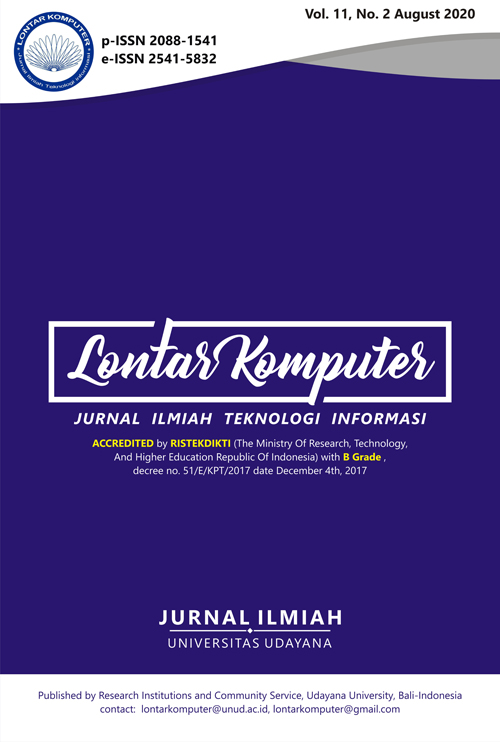Improving Network Performance of IP PBX Based Telecommunication System
Abstract
IP-PBX based communication has become a human need in the era of technology. Some researchers design a wireless telecommunication system based on IP PBX using Raspberry Pi. The previous researches have small network coverage and problematic on the ability of the system to support multiple concurrent connections. Based on these problems, these research aims are to expand the coverage area and increase the number of concurrent calls. This study used Asterisk FreePBX for the media configuration of the servers. The clients: laptops and smartphone devices used Linkin and Bria softphone. The testing was conducted in terms of voice and video services in the form of signal strength, CPU performance of servers, and network performance parameters such as delay, jitter, and packet loss. The results obtained that the CPU performance of the servers for seven calls simultaneously is around 16.9% compared with previous research, at an average of 45%. Based on ETSI standards, the measurement of network performance parameters when communicating between clients outperform than previous research. The clients can communicate well up to 390 meters.
Downloads
References
[2] L. Hernandez and M. Ospina, “Scheme and Creation of a Prototype for the Supervision of Lights and Electronic Devices with a PBX, using a WLAN Solution Based on IoT,” in 2019 IEEE Colombian Conference on Communications and Computing (COLCOM), 2019, pp. 1–6, doi: 10.1109/ColComCon.2019.8809159.
[3] J. P. B. López and Y. M. Pérez, “Integration of Asterisk IP-PBX with ESP32 Embedded System for Remote Code Execution,” in The 2nd XoveTIC Congress, 2019, pp. 1–3, doi: 10.3390/proceedings2019021038.
[4] S. El Brak, M. Bouhorma, M. El Brak, and A. A. Boudhir, “VoIP Applications over MANET: Codec Performance Enhancement by Tuning Routing Protocol Parameters,” J. Theor. Appl. Inf. Technol., vol. 50, no. 1, pp. 68–75, 2013.
[5] R. Narula and P. Aggarwal, “Performance Evaluation of RIP and OSPF in IPv6 Using Opnet 14 . 5 Simulator,” Int. J. Tech. Res. Appl., vol. 2, no. 6, pp. 37–41, 2014.
[6] J.-C. Chen and T. Zhang, IP-Based Next Generation Wireless Networks. New Jersey: John Wiley & Sons, Inc, 2013.
[7] S. Khan and N. Sadiq, “Design and Cofiguration of VoIP based PBX using Asterisk Server and OPNET Platform,” in 2017 International Electrical Engineering Congress (iEECON), 2017, pp. 1–4, doi: 10.1109/IEECON.2017.8075808.
[8] F. Iseki, Y. Sato, and M. W. Kim, “VoIP System based on Asterisk for Enterprise Network,” in International Conference on Advanced Communication Technology (ICACT), 2011, pp. 1284–1288.
[9] A. Robar, FreePBX 2.5 Powerful Telephony Solutions, 1st ed. Birmingham, Mumbai, 2009.
[10] P. Mahler, VoIP Telephony With Asterisk A Technical Overview of the Open Source PBX, 2nd ed. USA: Signate, 2005.
[11] D. Peláez, J. A. Estrada, C. Tipantuña, and J. C. Estrada, “Performance Analysis of a Raspberry Pi Based IP Telephony Platform,” Rev. Politec., vol. 36, no. 1, pp. 72–77, 2015.
[12] P. V. and V. M. Deshmukh, “Implementing the VOIP Communication Principles using Raspberry Pi as Server,” Int. J. Comput. Appl., vol. 124, no. 4, pp. 34–38, 2015, doi: 10.5120/ijca2015905449.
[13] Wardi, A. Achmad, Z. B. Hasanuddin, D. Asrun, and M. S. Lutfi, “Portable IP-based Communication System using Raspberry Pi as Exchange,” in Proceedings - 2017 International Seminar on Application for Technology of Information and Communication (iSemantic), 2017, pp. 198–204, doi: 10.1109/ISEMANTIC.2017.8251869.
[14] F. Farid, S. Shahrestani, and C. Ruan, “QoS Evaluation of Heterogeneous Networks: Application-Based Approach,” Int. J. Comput. Networks Commun., vol. 8, no. 1, pp. 47–60, 2016, doi: 10.5121/ijcnc.2016.8104.
[15] M. O. Ortega, G. C. Altamirano, and M. F. Abad, “Evaluation of the Voice Quality and QoS in Real Calls using Different Voice over IP Codecs,” in 2018 IEEE Colombian Conference on Communications and Computing (COLCOM), 2018, pp. 1–6, doi: 10.1109/ColComCon.2018.8466727.
[16] ETSI, “Telecommunications and Internet Protocol Harmonization Over Networks (TIPHON); General Aspects of Quality of Service (QoS),” 1999. [Online]. Available: http://www.etsi.org/deliver/etsi_tr/101300_101399/101329/02.01.01_60/tr_101329v020101p.pdf.
[17] ETSI, “Digital Enhanced Cordless Telecommunications ( DECT ); Compatibility with Cellular Technologies Operating on Frequency Block Adjacent to the DECT Frequency Band,” 2013. [Online]. Available: https://www.etsi.org/deliver/etsi_tr/103000_103099/ 103089/01.01.01_60/tr_103089v010101p.pdf.
The Authors submitting a manuscript do so on the understanding that if accepted for publication, the copyright of the article shall be assigned to Jurnal Lontar Komputer as the publisher of the journal. Copyright encompasses exclusive rights to reproduce and deliver the article in all forms and media, as well as translations. The reproduction of any part of this journal (printed or online) will be allowed only with written permission from Jurnal Lontar Komputer. The Editorial Board of Jurnal Lontar Komputer makes every effort to ensure that no wrong or misleading data, opinions, or statements be published in the journal.
 This work is licensed under a Creative Commons Attribution 4.0 International License.
This work is licensed under a Creative Commons Attribution 4.0 International License.























